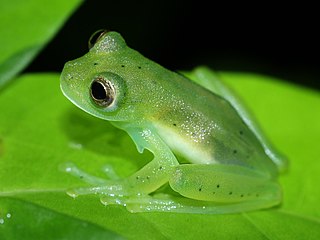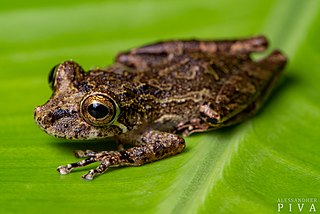
The Andes giant glass frog is a species of frog in the family Centrolenidae. It is found in the Cordillera Oriental of Colombia and the Mérida Andes and Serranía del Perijá of Venezuela.
Ololygon alcatraz is a species of frog in the family Hylidae. It is endemic to Ilha dos Alcatrazes, an island off the coast of São Paulo state, Brazil. Common name Alcatraz snouted Treefrog has been coined for it.

Scinax elaeochroa, commonly known as the Sipurio snouted treefrog, or olive snouted treefrog, is a species of frog in the family Hylidae. It is found in the Caribbean lowlands of Nicaragua and Panama and in the Pacific lowlands of Costa Rica and Panama, with an isolated population in Colombia.
Cycloramphus acangatan is a species of frog in the family Cycloramphidae. It is endemic to the Serra de Paranapiacaba, the state of São Paulo state, Brazil. The specific name acangatan is derived from the Tupi language words acanga ("head") and atan ("strong") and refers to the strong and massive jaw adductor muscles in this species.

Cycloramphus is a genus of frogs in the family Cycloramphidae. The genus is endemic to the southeastern Brazil. They are sometimes known as the button frogs.
Cycloramphus cedrensis is a species of frog in the family Cycloramphidae. It is endemic to southern Brazil and is only known from its type locality near Rio dos Cedros, Santa Catarina. Common name Cedros button frog has been coined for it.
Cycloramphus dubius is a species of frog in the family Cycloramphidae. It is endemic to the state of São Paulo, Brazil. Common name São Paulo button frog has been coined for it.
Cycloramphus duseni is a species of frog in the family Cycloramphidae. It is endemic to southern Brazil and only known from its type series collected in 1911 from near Casa Ypiranga along the Curitiba–Paranaguá railway, in the Serra do Mar, Paraná state. Prior to naming of Cycloramphus izecksohni in 1983, it was confused with this species. The specific name duseni honors Per Dusén, Swedish naturalist who collected the type series. Common name Ypiranga button frog has been coined for this species.

Cycloramphus eleutherodactylus is a species of frog in the family Cycloramphidae. It is endemic to the Serra do Mar in southeastern Brazil, including the Serra dos Órgãos, Serra da Mantiqueira, and Serra da Bocaina. Common name Alto button frog has been coined for it.
Cycloramphus izecksohni is a species of frog in the family Cycloramphidae. It is endemic to southern Brazil and occurs in the Serra do Mar in the states of Santa Catarina, Paraná, and São Paulo. Prior to its description in 1983, it was confused with Cycloramphus duseni. Common name Izecksohn's button frog has been coined for this species.
Cycloramphus mirandaribeiroi is a species of frog in the family Cycloramphidae. It is endemic to Brazil. Its natural habitats are subtropical or tropical moist lowland forests and rivers. Its population is in decline.

Cycloramphus stejnegeri is a species of frog in the family Cycloramphidae. It is endemic to the Serra dos Órgãos in southeastern Brazil. The specific name stejnegeri honors Leonhard Stejneger, a Norwegian–American herpetologist and ornithologist. Common name Stejneger's button frog has been coined for this species.
Physalaemus deimaticus is a species of frog in the family Leptodactylidae. It is endemic to Brazil and only known from its type locality in Jaboticatubas, Serra do Cipó, Minas Gerais. The specific name deimaticus is derived from Greek deimos fror "fear" and refers to the defensive display of this frog, probably aimed at scaring predators. Common names Jaboticatubas dwarf frog and frightening foam froglet have been coined for it.

Thoropa is a genus of frogs in the family Cycloramphidae. They are endemic to eastern and southeastern Brazil. They are sometimes known as river frogs.
Phrynobatrachus pakenhami is a frog species in the family Phrynobatrachidae. It is endemic to Pemba Island off Tanzania. It is similar to Phrynobatrachus acridoides, its sister species, but the two species differ in ecology and male advertisement call. On the other hand, the recently described, supposed diminutive species P. nigripes was simply based on juveniles and subadults of P. pakenhami.
Cornufer batantae is a species of frog in the family Ceratobatrachidae. It is endemic to West Papua, Indonesia, and is known from two islands near the New Guinean mainland, Batanta and Waigeo. There are also unconfirmed records from Yapen and Gag Islands. Common name Batanta wrinkled ground frog has been coined for the species.
Ptychadena trinodis is a species of frog in the family Ptychadenidae. Its common name is Dakar grassland frog. It is widely distributed in West and Middle Africa, and following the International Union for Conservation of Nature (IUCN), occurs in Benin, Cameroon, Central African Republic, Chad, Democratic Republic of the Congo, Gambia, Ghana, Guinea, Ivory Coast, Mali, Mauritania, Nigeria, Senegal, and Togo. Further, records are missing from Guinea-Bissau, Burkina Faso, Niger, South Sudan, and Sudan, but it is presumed to be present in these countries too.
Rohanixalus punctatus is a species of frog in the family Rhacophoridae. It is endemic to Myanmar.
Brachycephalus ferruginus is a species of frogs in the family Brachycephalidae. It is endemic to southern Brazil and only known from its type locality, Pico Marumbi, in the Serra do Mar in Morretes, Paraná state. Its altitudinal range is 965–1,470 m (3,166–4,823 ft) above sea level.

Ololygon is a genus of frogs in the family Hylidae. The majority of species in it are endemic to the Atlantic Forest of eastern Brazil, although the range of some species, including Ololygon aromothyella and Ololygon berthae, is known to extend south to northeastern Argentina, southern Paraguay, and Uruguay.







